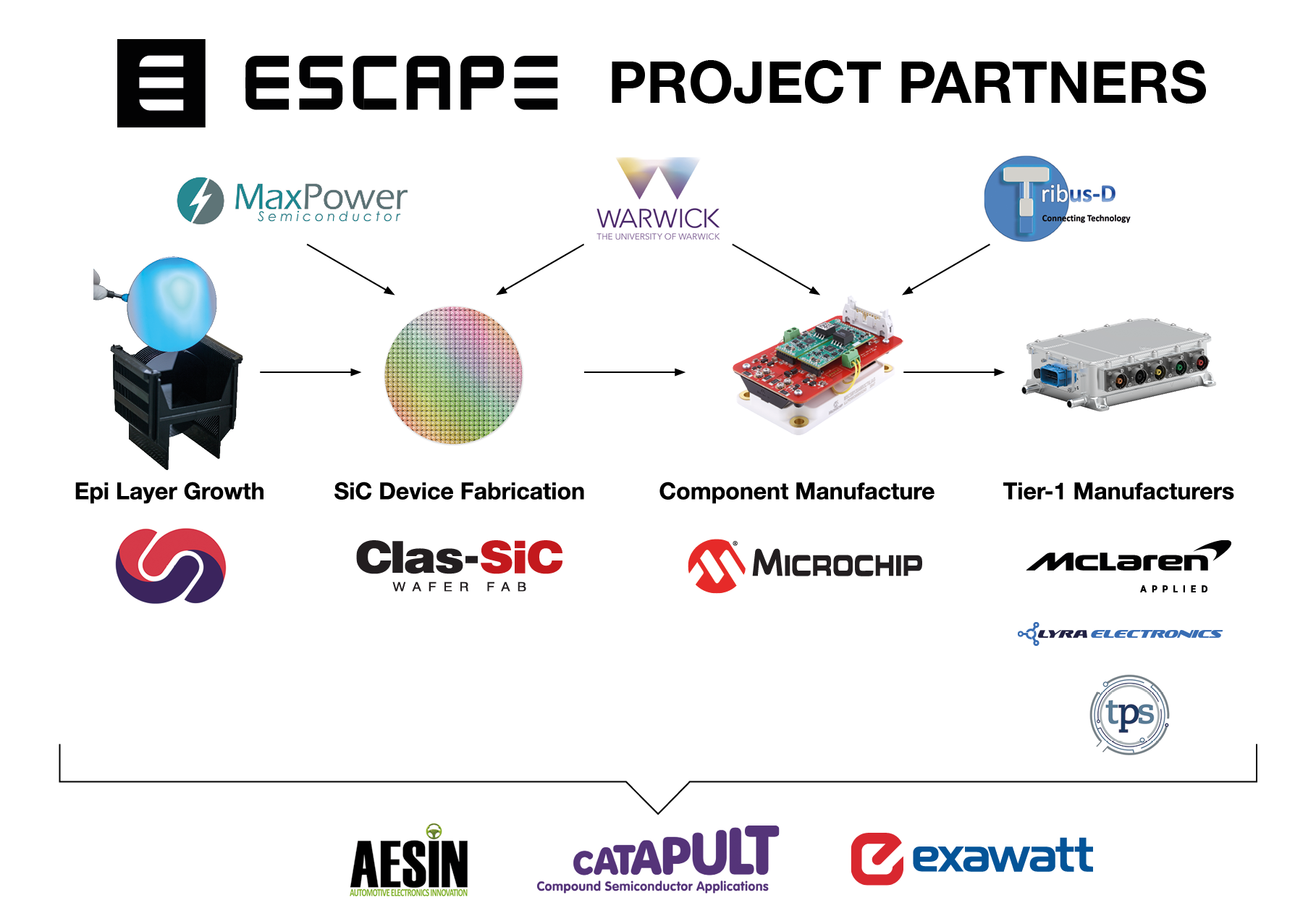TECHNOLOGY

EPI LAYER GROWTH
- This is the fundamental building block for the SiC device processing and CSC prepare the raw substrates through an epitaxial deposition process.
- This process is critical in preparing the SiC wafer for use in the Wafer Fabrication process where the crystal structure, purity and uniformity are crucial in achieving the target yield and reliability of the final devices.
SiC DEVICE DESIGN AND FABRICATION
- The SiC Device and Fabrication process is designed ‘vertical trench MOSFET’ (MaxPower Semiconductor/University of Warwick) and then implemented using Reticle Masks at the Wafer Manufacturing process (Clas-SiC).
- The SiC wafers are 6″ in diameter and there are >100 individual SiC power switching devices on each one.
- The wafers are 250um thick and the processing includes >100 individual process steps and takes several weeks from beginning to end.
COMPONENT MANUFACTURE
- The SiC Devices are diced after the Wafer Manufacturing phase into individual devices or “die” or “chips”, ready to be mounted on substrates and encapsulated into individual packaged devices or multi-chip modules (Microchip).
- Novel embedded and miniaturised packaging techniques are being evaluated to provide improved thermal management and reduced parasitics, leading to higher power densities and improved efficiency (Tribus-D).
- The packaged devices and multi-chip modules are then mounted onto a specially designed heatsinks with thermal management features.
TIER 1 – END PRODUCT MANUFACTURE
- The SiC device sub modules are then assembled into a specially designed Inverter module and casing (McLaren Applied) providing all required cooling and protection for use in final application.
- SiC devices are also used in the development of the EV Charger system (TPS) providing an MV connected fast charge capability that can allow vehicles to reach 80% charge in approx. 20mins.
- SiC devices are used in development of the high power DC-DC Converter (Lyra Electronics) enabling novel vehicle topologies to maximise the efficiency and operational performance of the final EV application.
SUPPLY CHAIN INNOVATION
- Co-design of innovative solutions through the supply chain
- Embedding the capability for future UK innovation and access
DEVICE INNOVATION
- Development and implementation of new vertical trench MOSFET with reduced die size
- Transfer of process to 6″ wafers, increasing count and reducing cost
PACKAGING INNOVATION
- Development and implementation of novel embedded and miniaturised packaging techniques
- Improved thermal management, leading to higher power densities
INVERTER INNOVATION
- Optimised SiC inverter design for automotive applications
DC/DC CONVERTER INNOVATION
- High power DC/DC converter enabling novel vehicle topologies
CHARGER INNOVATION
- Electric vehicle charger, connected to the medium-voltage grid
Silicon Carbide Inverter
McLaren Applied’s 800V Silicon Carbide Inverter, IPG5, is the ideal solution for automotive OEMs who want to deliver the next generation of electric vehicles. It paves the way for electric vehicles to adopt a faster, more efficient and lightweight drivetrain that delivers faster charging, higher efficiency and longer range.
McLaren Applied has been pushing the boundaries of inverter technology for over a decade, through high-performance automotive and motorsport applications, culminating in this fifth-generation inverter that takes cutting-edge development from Formula 1 and optimises the technology for the wider automotive market. IPG5 uses Silicon Carbide (SiC) technology which delivers a significant increase in switching frequency allowing the use allows the use of a faster, more efficient and lightweight drivetrain, including the inverter, motor and battery systems.
This drive for efficiency allows for overall vehicle component optimisation, including reduction in battery size, driving further weight and sustainability benefits. The combination of the smaller battery, with a downsized cooling system, the lower size and weight of IPG5 itself and the smaller, higher speed motor that IPG5 enables, means that weight and cost are reduced throughout the drivetrain. All these benefits are delivered through the use of SiC.
Medium Voltage EV Charging Station
Turbo Power Systems is developing unique EV charging equipment that can provide ultra-rapid vehicle charging from the Medium Voltage (MV) electricity distribution network where greater available electricity capacity can be accessed.
A modular solid state Medium Voltage to Low Voltage sub-station converter is being developed, using the ESCAPE Silicon Carbide power module, which enables extremely high-power conversion efficiencies and an equipment footprint much smaller than that of a traditional transformer.
A unique DC rapid vehicle charger has also been developed, using Silicon Carbide technology, to enable a highly efficient, galvanically isolated, solution. The charger is capable of delivering up to 120kW and four chargers can be connected to a single sub-station converter; ideal for applications such as delivery vans and public transport vehicles. Using this smart approach to charging will reduce installation costs and energy bills for the vehicle operator.



